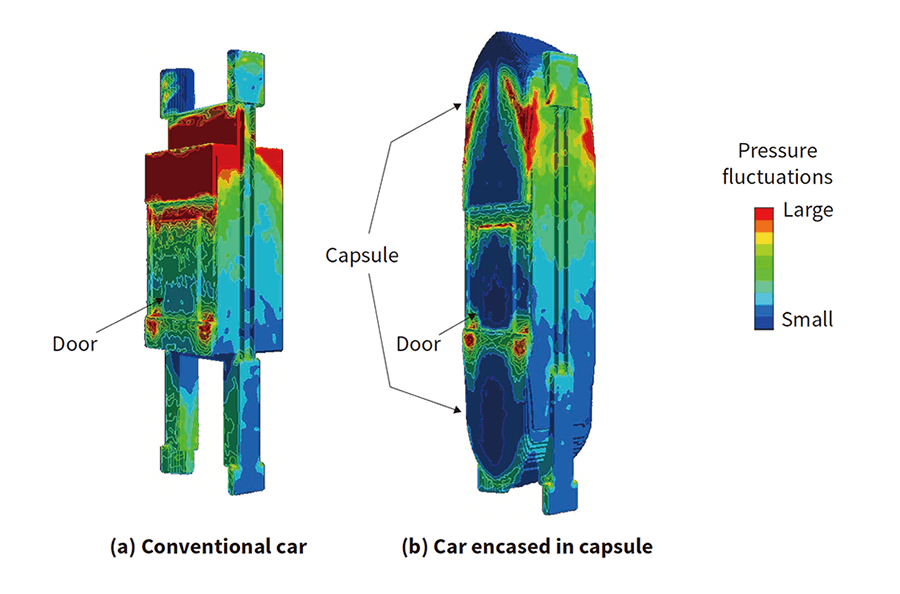Technological Innovations Accelerating Worldwide Digitalization
In rolling stock and elevator development, products that meet international regulations and the diverse requirements of customers must be developed in a short time and, to that end, the analysis-led design that incorporates performance gained through analysis in the design stage is essential. This article, with regard to comfort (noise and vibration), which is a common problem for rolling stock and elevators, introduces examples of comfortable indoor space development achieved through the utilization of noise and vibration (dynamics) analysis technology. With regard to railways, the article will also introduce case studies that use collision analysis to improve safety. Furthermore, the article demonstrates the work Hitachi is doing on design and development that takes into account operation environment conditions, such as the wear and tear of wheels and rails to maintain performance over the long-term. As a first step, the article introduces state monitoring technology for rolling stock and operational environment conditions of railway rolling stock.

Advanced Simulation Research Department, Center for Technology Innovation – Mechanical Engineering, Research & Development Group, Hitachi, Ltd. Current work and research: Research and development of advanced simulations. Society memberships: Japan Society of Mechanical Engineers (JSME) and Director of the Visualization Society of Japan.

Reliability Science Research Department, Center for Technology Innovation – Mechanical Engineering, Research & Development Group, Hitachi, Ltd. Current work and research: Research and development of technologies for structural strength evaluation of rolling stock. Society memberships: JSME, the Society of Materials Science, Japan (JSMS), the Japan Society for Composite Materials (JSCM).

Thermal Fluidic Systems Research Department, Center for Technology Innovation – Mechanical Engineering, Research & Development Group, Hitachi, Ltd. Current work and research: Development of noise prediction and reduction technology for rolling stock. Society memberships: JSME and the Society of Automotive Engineers of Japan (JSAE).

Advanced Simulation Research Department, Center for Technology Innovation – Mechanical Engineering, Research & Development Group, Hitachi, Ltd. Current work and research: Research and development of dynamics simulations for rolling stock. Society memberships: JSME.

Advanced Simulation Research Department, Center for Technology Innovation – Mechanical Engineering, Research & Development Group, Hitachi, Ltd. Current work and research: Research and development of condition monitoring systems for rolling stock. Society memberships: JSME.

Robotics Research Department, Center for Technology Innovation – Mechanical Engineering, Research & Development Group, Hitachi, Ltd. Current work and research: Research and development of elevators. Society memberships: JSME and the Society of Instrument and Control Engineers (SICE).
In recent years, environmental issues such as global warming have been drawing worldwide attention. Together with an increase in the world's population, there is also an increase in large cities that have a population of 1 million or more. In these cities, the development of highly efficient means of transport that boast a low environmental impact are becoming more important. Furthermore, there is a growing need for improving the safety and comfort of the means by which people are transported. In response to these social needs, focusing mainly in the mobility sector on rolling stock, elevators, etc., the Hitachi Group is promoting the development of technology that aims to provide comfortable transportation systems that have a low environmental impact.
This article describes Hitachi's analysis-led design initiatives for product design and development of rolling stock and elevators in the mobility sector, and case studies of the application of analysis-led design to products.
In the design and development of rolling stock, products must be designed to meet worldwide standards and customer specifications. This applies to safety (collision and operational safety), passenger comfort (internal noise, comfort of travel, and air conditioning), and environmental impact (external vehicle noise). However, because the range of tests that can be performed using an actual vehicle is limited, Hitachi is promoting the application of numerical analysis to design and development.
Hitachi is conducting performance evaluation and optimization design through analysis-led design which uses the measurement results of actual vehicles and element specimens, and large-scale numerical analysis using a supercomputer. Additionally, to take the first step in analyzing performance in the operational state, the Company is working on the development of state monitoring technology. Representative examples of these technologies are outlined below.
For railway trains in Europe, crashworthiness design is required to comply with a high level of regulation, and the design of the structures that absorb collision energy (hereafter “crashworthy structures”) become substantially important for protecting passengers and crews from collision accidents. European standards on crashworthiness require a numerical analysis simulating the collision of train units to validate crashworthiness and a full-scale mockup test to evaluate the performance of crashworthy structures.
Hitachi has developed crashworthiness analysis technology for predicting structural energy absorption with high accuracy, and this technology has been applied to the crashworthiness design of vehicles in the UK (see Figure 1). This crashworthiness analysis technology has achieved prediction accuracy that complies with the requirements of European standards (less than 10% error compared with test) by taking into account the complicated deformation behavior accompanied by fractures (see Figure 2). By means of this analysis technology, a crashworthy structure that significantly reduces the number of components compared with conventional rolling stock was designed for the rolling stock of the UK Intercity Express Programme (IEP). A space-saving crashworthy structure that efficiently absorbs collision energy by gradual mitigation and distribution of the collision impact was designed for UK Abellio ScotRail.
Reducing rolling stock internal noise is an essential element in the quest to improve passenger comfort. However, internal noise tends to increase together with vehicle speed and weight reduction improvements, which increases the importance of prediction and reduction technology at the design stage. Figure 3 shows a case study in which analysis was applied in the design of vibration isolation for a floor structure, which was conducted to reduce internal noise in the development of dual-mode rolling stock equipped with an engine generator unit under the floor. In large-scale structures such as railway rolling stock, analyzing internal noise using the full finite element method (FEM) is not practical, therefore a method called statistical energy analysis (SEA) is applied, which is suitable to problems involving high frequency.
However, SEA requires parameters such as that representing the energy transfer rate at the coupling section between structural elements, and conventionally, the challenge was that the only way to identify these was through experimental means using existing rolling stock. For that reason, Hitachi developed a method for calculating these parameters from the detailed FEM model of partial structures, which includes coupling sections, and use them to construct a SEA model of the whole vehicle. Additionally, Hitachi performed an engine operation test using actual rolling stock and, as shown in Figure 3 (c), was able to verify analysis accuracy sufficient for practical use.
Using this analysis technology, Hitachi achieved a floor vibration isolation support structure that is effective even when the underfloor engine is in operation, which meets the specifications for internal noise.
Figure 3—Analysis Case Study of Internal noise, including Input from Underfloor Engine Internal noise is analyzed using the SEA model, and results are used for the structural design of each part, which is required to achieve specification values.
Internal noise is analyzed using the SEA model, and results are used for the structural design of each part, which is required to achieve specification values.
In the development of safe and comfortable rolling stock, it is important to improve running performance, such as running safety and ride comfort. Therefore, to predict the running performance of rolling stock in the design stage, Hitachi has developed dynamics analysis technology for rolling stock and has applied it to the design of rolling stock (see Figure 4).
This analysis technology, based on multibody dynamics theory, models railway rolling stock with a spring mass damper that has multiple degrees of freedom. By inputting track excitation into this rolling stock model, it is possible to predict vehicle displacement and acceleration, and to evaluate running safety and ride comfort.
The rest of this section introduces a case study involving the application of dynamics analysis to the development of rolling stock for the UK. In the UK, standards require manufacturers to predict the displacement of moving rolling stock through analysis, to guarantee safety against interference between rolling stock and infrastructure, and to verify the accuracy of vehicle displacement analysis when rolling stock is tilted, as shown in Figure 5 (a). In addition to the conventional support of the wheelset on the outer frame bogie, as shown in Figure 5 (b), some of this rolling stock also has inner frame bogie support for the wheelset inside the bogie frame, which was newly developed to reduce the weight. Although there is a difference in the response of the rolling stock displacement in these bogies due to the different support positions of the wheelsets, as Figure 5 (c) shows, Hitachi has verified that analysis can adequately predict the rolling stock displacement of both bogies. By using this analysis technology to predict the running performance of rolling stock when operating, and reflecting that in the rolling stock design, Hitachi has contributed to the design of rolling stock that can run safely and comfortably on the main line.
To maintain and improve rolling stock comfort and safety during long-term operation, Hitachi is working to develop noise and vibration analysis technology that takes into account operating environment conditions such as the wear and tear on wheels and rails. As a first step, Hitachi is promoting the development of state monitoring technology for rolling stock and operational environment conditions.
Figure 6 (a) is an example of a state monitoring system for vibration and internal noise relating to the comfort and safety of rolling stock. This case study covers a system configuration that monitors vibration riding comfort with a vibration accelerometer and internal noise with a microphone in coordination with a train management system. The train management system manages not only information on rolling stock composition, such as vehicle speed and destination, but also operational information on equipment, such as railway electrical equipment installed in each rolling stock. The state monitoring system monitors the relationship between the rolling stock operational information and the vibration and internal noise. Figure 6 (b) is a case study visualizing the relationship between rolling stock vibration ride comfort, travel position, and the rolling stock operation progress, making it possible to understand the temporal and spacial changes in vibration ride comfort.
In the future, Hitachi plans a deeper analysis and evaluation of big data obtained by these state monitoring systems and to utilize it in improving rolling stock maintenance efficiency and for rolling stock design feedback that takes into account actual operation conditions.
Figure 6—State Monitoring Case Study Using State Monitoring System By visualizing the vibration ride comfort, the travel position, and the travel distance, it becomes possible to understand the impact of the travel position and changes over time.
By visualizing the vibration ride comfort, the travel position, and the travel distance, it becomes possible to understand the impact of the travel position and changes over time.
As the population ages and becomes concentrated in major cities, the elevators that provide the means of vertical mobility within buildings continue to increase, particularly in high-rise buildings, where they are becoming an indispensable lifeline. This section explains how analysis technology is being used in an early-stage response to standards set by various countries for safety and security, and to the demand for comfort. These developed technologies have been implemented in an ultra-high-speed elevator in Guangzhou, China that has been measured traveling at a speed of 1,260 meters per min, the world's fastest speed (as of February 2019, according to Hitachi research).
One of the indicators of elevator comfort is car vibration. Car vibration, which includes vertical and horizontal vibration, needs to be suppress below a specified value, because it is easy for humans to feel vibrations in the low frequency range. The following introduces analysis-led design for reducing vibration in the horizontal direction.
To design an elevator car with reduced lateral vibration, it is first necessary to create an appropriate analysis model and to understand the sources of disturbance that excite vibration. To create the analysis model of an elevator car vibration system, Hitachi established a modeling method that uses the frequency domain decomposition (FDD) method, which provides an understanding of mode characteristics from the acceleration data of actual elevators in an operating state and identifies the mechanical characteristics of elevator car vibration systems. Applying this method, it conducted low-dimensional analytical modeling consisting of springs and dampers on a rigid body to simulate a car, and four guide units. Disturbance sources that excite lateral vibration include irregularities in guide rails (bending and leveling) and wind pressure brought on by passing counterweights in the case of high-speed elevators. To address these issues, the guide rail irregularities were input into the model as forced displacements based on installation errors and standards, and the wind pressure estimated using unsteady fluid flow analysis was input into the model.
The following describes the system design of the active guide units to which this modeling method was applied (see Figure 7). In ultra-high-speed elevators that exceed 10 m/s, there are more vibration modes that are excited, which makes vibration control design more complex. In conventional systems, the active guide units are installed only on the lower guide units, but analysis revealed the necessity to install it on both the upper and lower guide units in order to cope with the increased vibration modes (see Figure 8). Moreover, to shorten the development period in the verification stage, Hitachi used hardware-in-the-loop simulation (HILS) and actual elevator testing to confirm how effective the above measure was. Then, it applied the system to actual elevators and confirmed that it was effective.
In Southeast Asia and the Middle East, many skyscrapers are constructed and there is a great need for ultra-high-speed elevators that support such buildings. However, faster elevators lead to an increase in vibration and noise, which can worsen comfort, not only inside the car, but also in each room in the vicinity of the elevator shaft. Above all, aerodynamic noise generated by a car pushing air in an elevator shaft is generally thought to increase by the power of six in proportion to the speed. Therefore, simply doubling the operating speed will result in a noise increase of about 18 dB.
To overcome this problem, Hitachi conducted studies to find capsule structures that suppress surface pressure fluctuations by changing air flow around a car. The effective shape was evaluated using computational fluid dynamics and shape optimization technology that was developed in the field of noise reduction along Shinkansen lines (see Figure 9). Note that the verification of numerical analysis was conducted through an experiment that used a wind tunnel and conversions based on the law of similitude. As a result, Hitachi confirmed that surface pressure fluctuations can be reduced by about 50% when compared to the conventional car shapes.
In addition, the fluid noise source was identified using the results of the above-mentioned computational fluid dynamics. By using it as input for acoustic analysis, fluid-acoustic coupling analysis technology was developed. The scope of application of this analysis technology has been extended to the evaluation of noise propagation in elevator hoistways and cars.
Figure 9—Evaluation of Car Surface Pressure Fluctuations Using Computational Fluid Dynamics Computational fluid dynamics and wind tunnel testing verified that pressure fluctuations are reduced by the car in streamlined capsules composed of curved surfaces.
Computational fluid dynamics and wind tunnel testing verified that pressure fluctuations are reduced by the car in streamlined capsules composed of curved surfaces.
This article described Hitachi's analysis-led design initiatives for product design and development of railway rolling stock and elevators in the mobility sector, and outlined some case studies of the application of analysis-led design to products.
For rolling stock and elevators in the mobility sector, analysis-led design is essential for shortening development stages, for ensuring product reliability, and for the globalization of products.
In the future, Hitachi plans to optimize operation and maintenance by constructing analysis technology that predicts, to a high degree of accuracy, the performance of products under operating environment conditions that are subject to a variety of changing factors, and will continue working to reduce product life cycle costs.